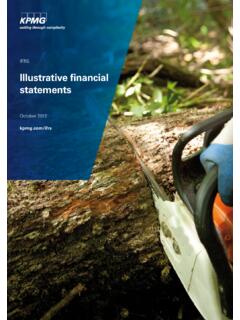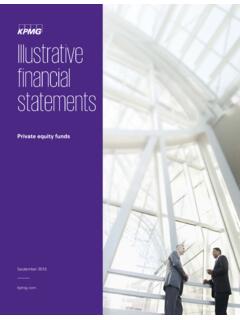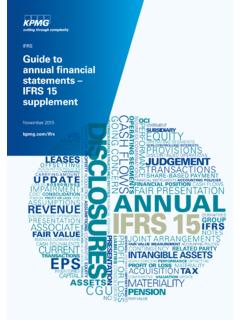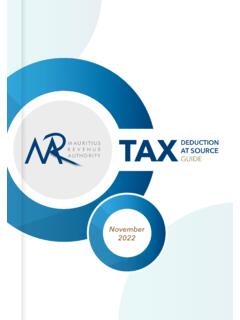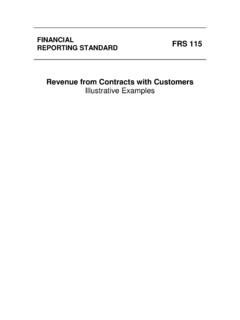Transcription of Revenue – IFRS 15 handbook - KPMG
1 RevenueIFRS 15 handbook June new challenges 1 Overview21 Step 1 Identify the contract with a customer Criteria to determine whether a contract Contract term Consideration received before a contract Combination of contracts 192 Step 2 Identify the performance obligations in the contract Distinct goods or services Implied promises and administrative tasks Series of distinct goods or services 393 Step 3 Determine the transaction price Variable consideration (and the constraint) Significant financing component Non-cash consideration Consideration payable to a customer Sales taxes 884 Step 4 Allocate the transaction price to the performance obligations in the contract Determine stand-alone selling prices Allocate the transaction price Changes in the transaction price 1115 Step 5 Recognise Revenue when or as the entity satisfies a performance obligation Transfer of control Performance obligations satisfied over time Measuring progress towards complete satisfaction of a performance obligation Performance obligations satisfied at a point in time Repurchase agreements
2 Consignment arrangements Bill-and-hold arrangements Customer acceptance 1616 Scope In scope Out of scope Partially in scope Portfolio approach 1717 Contract costs Costs of obtaining a contract Costs of fulfilling a contract Amortisation Impairment 1928 Contract modifications Identifying a contract modification Accounting for a contract modification 1989 Licensing Licences of intellectual property Determining whether a licence is distinct Determining the nature of a distinct licence Timing and pattern of Revenue recognition Contractual restrictions and attributes of Sales- or usage-based royalties 22510 Other application issues Sale with a right of return Warranties Principal vs agent considerations Customer options for additional goods or services Customers unexercised rights (breakage)
3 Non-refundable up-front fees Sales outside ordinary activities 29511 Presentation Statement of financial position Statements of profit or loss and cash flows 31212 Disclosure Annual disclosure Interim disclosures 32513 Effective date and transition Transition Retrospective method Cumulative effect method Consequential amendments to other ifrs First-time adoption 342 Guidance referenced 344 Detailed contents 345 Index of examples 348 Index of KPMG insights 355 About this publication 363 Keeping in touch 364 Acknowledgments366 2019 KPMG IFRG Limited, a UK company, limited by guarantee.
4 All rights new challengesReporting Revenue under ifrs 15 is now one of the ordinary activities of companies in the 100+ countries that use ifrs Standards. So this feels like the right time to take stock to pull together, in one place, what we have learned about this new world of Revenue the past five years, we like you have wrestled with the many challenges of implementing ifrs 15. In doing so, we have gained extensive insight and hands-on experience across different industries and geographies. And we are delighted to share our experience with you in our ifrs 15 handbook : Revenue . It provides detailed guidance, illustrative examples and extensive discussion of the areas that companies have found most complex.
5 Looking forward, as your business grows and evolves whether by developing new products and services, embedding technological innovations or buying new businesses we hope this handbook will be your go-to resource as you apply ifrs 15 to new facts and circumstances. Prabhakar Kalavacherla (PK) Brian O Donovan Anne Schurbohm Kim HengKPMG Global Revenue Recognition Leadership Team 2019 KPMG IFRG Limited, a UK company, limited by guarantee. All rights handbook provides a detailed analysis of the Revenue standard, ifrs 15 Revenue from Contracts with Customers, including insights and examples to help entities to navigate the Revenue recognition requirements.
6 In many cases, further analysis and interpretation may be needed for an entity to apply the requirements to its own facts, circumstances and individual transactions. Furthermore, some of our insights may change and new insights will be developed as issues from the implementation of the Revenue standard arise and as practice of the textThe following diagram highlights the layout of the Revenue standard and the corresponding sections in this handbook . Each section provides an overview, the requirements of the standard, examples illustrating basic scenarios and our insights. Some sections also have additional application examples illustrating more complex scenarios or sector-specific issues.
7 (13)Effective dateand transition(7)Contractcosts(8)Contractmod ifications(9)Licensing(10)Other applicationissues(11)Presentation(12)Dis closure(2)Step 2 Identifyperformanceobligations(3)Step 3 Determinethe transactionprice(4)Step 4 Allocate thetransactionprice(5)Step 5 Recogniserevenue(1)Step 1 Identify thecontractPresentation and implementation5-step modelOther recognition and measurement guidance(6)Scope2 | Revenue ifrs 15 handbook 2019 KPMG IFRG Limited, a UK company, limited by guarantee. All rights Step 1 Identify the contract with a customer | Criteria to determine whether a contract exists | 1 Step 1 Identify the contract with a customerOverviewA contract with a customer is in the scope of the standard when the contract is legally enforceable and certain criteria are met.
8 If the criteria are not met, then the contract does not exist for the purpose of applying the general model of the standard, and any consideration received from the customer is generally recognised as a deposit (liability). Contracts entered into at or near the same time with the same customer (or a related party of the customer) are combined and treated as a single contract when certain criteria are Criteria to determine whether a contract existsIFRS standard defines a contract as an agreement between two or more parties that creates enforceable rights and obligations and specifies that enforceability is a matter of law.
9 Contracts can be written, oral or implied by an entity s customary business practices. ifrs contract does not exist when each party has the unilateral right to terminate a wholly unperformed contract without contract with a customer is in the scope of the standard when it is legally enforceable and meets all of the following collection ofconsideration it has it is approvedand the parties arecommitted totheir rights to goodsservices andorpayment terms canbe identifiedA contractexists 2019 KPMG IFRG Limited, a UK company, limited by guarantee. All rights | Revenue ifrs 15 handbookIFRS (e)In making the collectability assessment, an entity considers the customer s ability and intention (which includes assessing its credit-worthiness) to pay the amount of consideration when it is due.
10 This assessment is made after taking into account any price concessions that the entity may offer to the customer (see Section ). ifrs the criteria are not initially met, then an entity continually reassesses the contract against them and applies the requirements of the standard to the contract from the date on which the criteria are met. Any consideration received for a contract that does not meet the criteria is accounted for under the requirements in Section a contract meets all of the criteria at contract inception, then an entity does not reassess the criteria unless there is an indication of a significant change in the facts and circumstances.

